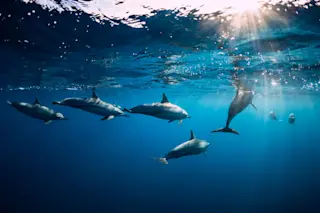If you picture a showdown between the chirpy dolphin and the toothy shark, you might imagine a pod ramming into the ocean’s iconic predator enough times to eventually kill it. To see such a predator done in by the animals we perceive as the underdogs certainly makes for a compelling role reversal.
“You’ve got these amazingly intelligent, incredible dolphin predators, in social groups with complex social lives, and then the iconic shark,” says Michael Heithaus, a professor in the Department of Biological Sciences at Florida International University and expert in marine predator-prey interactions. “What’s not to love about it?”
However, the actual work of observing and recording direct encounters between the two species is where the waters get murkier. Today, does the sailor’s myth that sharks fear dolphins hold true?
(Credit: Tharuka Photographer/Shutterstock)
Tharuka Photographer/Shutterstock
The idea that sharks fear dolphins is, really, just an old sailor’s myth, according to ...















